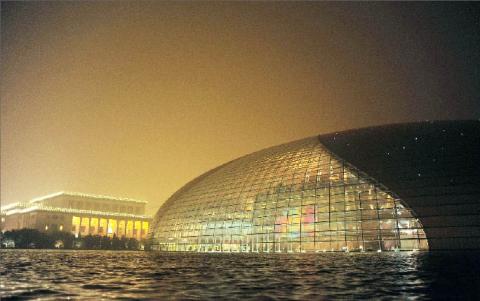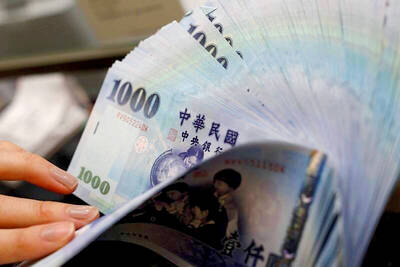China and other rapidly developing Asian nations are attracting cutting-edge international architects as their increasingly futuristic skylines offer the chance to push design boundaries.
French architect Paul Andreu was handed what he calls a once-in-a-lifetime opportunity when Chinese authorities picked him to design an ultra-modern opera house in the center of Beijing.
“I’m grateful towards China,” said Andreu, whose 300 million euro (US$430 million) opera house — a rounded titanium and glass structure — rises from a man-made moat next to the Forbidden City and Tiananmen Square.

Photo: AFP
“That was an opportunity that you only get once in your life, if at all,” said the award-winning architect, who is currently working on two other projects in China. “China is building a huge amount, so opportunities are huge. But China also has a lot of ambition. For years, they didn’t do much, and I’m sure they had the feeling they were lagging behind.”
Now, the Asian powerhouse — whose breakneck growth over the past 30 years has transformed it into the world’s second-largest economy and fueled a colossal construction boom — is making up for lost time.
The 90,000-seat “Bird’s Nest” stadium, which became the centerpiece of the 2008 Olympics with its threads of interlocking steel beams, is probably the best known of innovative structures that dot China’s skyline.
Beijing’s soaring CCTV (中國中央電視台) tower — described as one of the most daring pieces of architecture ever attempted — and Shanghai’s 101-story World Finance Center are also high-profile examples of cutting-edge design.
Andreu is designing a colorful archaeological museum in the northern city of Taiyuan and Zaha Hadid — the first woman to receive the Pritzker Architecture Prize — has just finished a 1,800-seat opera house in southern Guangzhou.
Renowned British architect Norman Foster, who designed the much-acclaimed Terminal 3 at Beijing’s international airport, is also building the headquarters for CITIC Bank (中信銀行) in the eastern city of Hangzhou.
Foreign firms are not the only ones taking advantage of opportunities in China. Homegrown architects are also making their mark at home and abroad.
Ma Qingyun (馬清運), whose firm MADA s.p.a.m. has countless projects across China, was named one of the world’s most influential designers by Businessweek last year, along with Hadid.
Earlier this month, the French Architecture Academy gave its gold medal — a top award — to Wang Shu (王澍), who focuses on sustainable design.
“The architectural arena is changing — it’s leaning towards more intellectual and creative freedom,” Andreu said.
Michael Tunkey, the Shanghai-based partner at international firm Cannon Design, said other countries in Asia were also proving a boon for architects.
“The fact that Chinese salaries have been rocketing over the last couple of years has generated larger opportunities for places like Vietnam and Thailand,” he said.
Nguyen Chi Tam, design director at HighEnd Architecture in Hanoi, said there had been “more and more” architect offices opening in Vietnam in recent years — both mid-sized firms and global giants.
“With a downturn in Europe, foreign firms have turned to Asia, including Vietnam,” he said.
Tam’s office is collaborating with famed Italian architect Renzo Piano on a project for a new opera house in Hanoi, while the New York-based Carlos Zapata recently worked on the 68-story Bitexco Financial Tower in Ho Chi Minh City.
However, as in Beijing where much of the old town has been torn down, Hanoi is having trouble preserving its heritage despite a law on conservation enacted in 2001.
“On paper there are still more than 1,000 French villas in Hanoi, but in my opinion, there are really only a few hundred that have kept their original colonial style,” said Hoang Dao Kinh, a Hanoi-based architect.
Preserving the old while embracing the new is a challenge that other Asian nations face too. Singapore, for one, has been relatively successful.
To date, more than 7,000 old buildings have been preserved by the city-state’s national planning authority, adapted into restaurants, offices or homes.
However, it is also the home of architectural feats such as the US$5.5 billion Marina Bay Sands resort that boasts three 55-story hotel towers linked by a huge sky park 200m above the sea.
Sustainable engineering is also starting to take hold in Asia. Ciputra World, a business and entertainment complex in Indonesia’s capital Jakarta, is one such example.
The 3 trillion rupiah (US$350 million) project aims to reduce energy usage by at least 20 percent compared to a regular building, with double-glazed windows and a sophisticated indoor air system.
Back in China, the Pearl River Tower in Guangzhou, due to be completed this year, has been dubbed “the world’s greenest skyscraper.”
Its structure directs winds to openings where they push turbines that generate the building’s energy, according to architecture firm SOM, which is working on the project.
Tunkey said China is still lagging far behind the US and Europe in terms of clean technology buildings.
“But if it decides to get in front of the curve, it has got the potential to ramp it up in a way that no other country really can,” he said.
Ma, meanwhile, said China faced a key challenge in the next few years in finding its own architectural path “that corresponds to Chinese people’s aesthetic habits and experiences.”

Merida Industry Co (美利達) has seen signs of recovery in the US and European markets this year, as customers are gradually depleting their inventories, the bicycle maker told shareholders yesterday. Given robust growth in new orders at its Taiwanese factory, coupled with its subsidiaries’ improving performance, Merida said it remains confident about the bicycle market’s prospects and expects steady growth in its core business this year. CAUTION ON CHINA However, the company must handle the Chinese market with great caution, as sales of road bikes there have declined significantly, affecting its revenue and profitability, Merida said in a statement, adding that it would

MARKET LEADERSHIP: Investors are flocking to Nvidia, drawn by the company’s long-term fundamntals, dominant position in the AI sector, and pricing and margin power Two years after Nvidia Corp made history by becoming the first chipmaker to achieve a US$1 trillion market capitalization, an even more remarkable milestone is within its grasp: becoming the first company to reach US$4 trillion. After the emergence of China’s DeepSeek (深度求索) sent the stock plunging earlier this year and stoked concerns that outlays on artificial intelligence (AI) infrastructure were set to slow, Nvidia shares have rallied back to a record. The company’s biggest customers remain full steam ahead on spending, much of which is flowing to its computing systems. Microsoft Corp, Meta Platforms Inc, Amazon.com Inc and Alphabet Inc are

RISING: Strong exports, and life insurance companies’ efforts to manage currency risks indicates the NT dollar would eventually pass the 29 level, an expert said The New Taiwan dollar yesterday rallied to its strongest in three years amid inflows to the nation’s stock market and broad-based weakness in the US dollar. Exporter sales of the US currency and a repatriation of funds from local asset managers also played a role, said two traders, who asked not to be identified as they were not authorized to speak publicly. State-owned banks were seen buying the greenback yesterday, but only at a moderate scale, the traders said. The local currency gained 0.77 percent, outperforming almost all of its Asian peers, to close at NT$29.165 per US dollar in Taipei trading yesterday. The

The US overtaking China as Taiwan’s top export destination could boost industrial development and wage growth, given the US is a high-income economy, an economist said yesterday. However, Taiwan still needs to diversify its export markets due to the unpredictability of US President Donald Trump’s administration, said Chiou Jiunn-rong (邱俊榮), an economics professor at National Central University. Taiwan’s exports soared to a record US$51.74 billion last month, driven by strong demand for artificial intelligence (AI) products and continued orders, with information and communication technology (ICT) and audio/video products leading all sectors. The US reclaimed its position as Taiwan’s top export market, accounting for